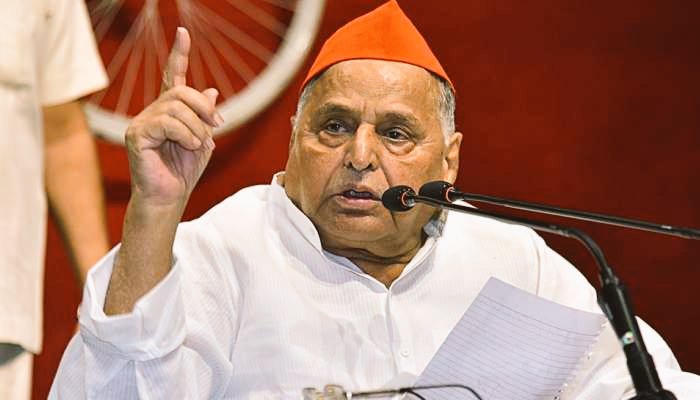
Mulayam: Astute politician with a finger on pulse of caste politics
Influenced by Ram Manohar Lohia’s thoughts, Mulayam Singh left the wrestler’s akhara to enter the political arena in 1967 and strode through the next five decades as a name to reckon with in Uttar Pradesh

From a wrestler to a consummate politician, Samajwadi Party patriarch Mulayam Singh Yadav’s long journey in public life was full of twists and turns.
Mulayam’s 55-year-long political innings saw him serve as an MLA for 10 terms, a Lok Sabha MP for seven terms and Chief Minister of Uttar Pradesh thrice, though never for a full five-year tenure.
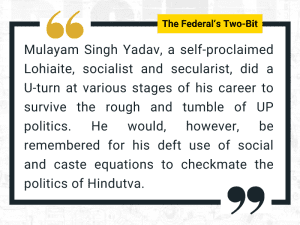
He came within striking distance of becoming the Prime Minister in 1996 but was knocked out of the race in the final lap and forced to settle as Union Defence Minister in the ultimately short-lived United Front government.
On Monday (October 10), Mulayam passed away at the age of 82. A few days ago, he was admitted in the Medanta Hospital in Gurugram, where he breathed his last.
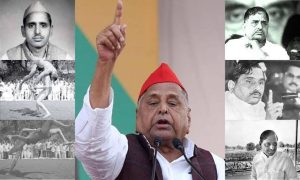
Early life
Born on November 22, 1939, in Saifai village of Uttar Pradesh’s Etawah district, Mulayam initially wanted to become a wrestler but got involved in politics at the age of 15, when he came across writings of socialist leader Ram Manohar Lohia. Lohia’s ideas on equality of people and social-justice issues strongly influenced Mulayam and shaped his political thoughts and career.
Mulayam’s first electoral victory came in 1967, when he won a seat in the Uttar Pradesh legislative assembly from Jaswantnagar on a Samyukta Socialist Party (SSP) ticket.
Mulayam became MLA from Jaswantnagar seven times. He won Lok Sabha polls from Mainpuri five times, from Sambhal twice and from Kannauj and Azamgarh once each.
Man of contradictions
Through his political journey, Mulayam made friends across party lines but none whose trust he could ever earn. For, Netaji, as he was popularly called, was also a master of deception whose support could never be relied upon. He could be your staunch ally one day and turn into a bitter rival the very next – a trait that leaders ranging from Chandra Shekhar, Ajit Singh and Kanshi Ram to Sonia Gandhi or even his own clan members such as his son Akhilesh Yadav and brother Shivpal Yadav got a taste of at different points in time.
Watch: Mulayam Singh Yadav passes away at 82
This contradiction could also be found in Mulayam the administrator. Though he would repeatedly pledge ideological allegiance to socialism, in each of his chief ministerial stints he presided over large-scale privatisation of UP’s sugar mills, cement factories and the power sector while also rewriting the economically backward state’s industrial policy to favour a handful of private entities.
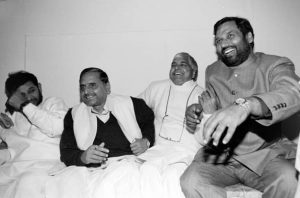
In his public appearances, Mulayam presented himself as a man who embraced simplicity, always dressed in a crumpled dhoti-kurta. Once, while attending a private dinner, someone brought Mulayam a plate of noodles and other assorted vegetarian Chinese fare only to see an embarrassed Netaji struggle with a fork. Raj Babbar (then an SP MP), who was also at the dinner, saw his leader’s plight and rushed in with a plate of Indian khana, much to Mulayam’s relief.
And yet, Mulayam seemed perfectly at ease in the company of his ostentatious and controversial aide, the late Amar Singh, who brought into the SP chief’s inner circle high flying celebrities and business tycoons such as Amitabh and Jaya Bachchan, Subrata Roy ‘Sahara’ and Anil Ambani.
Equations in Charan Singh’s BLD
Though he made a successful electoral debut in 1967, it wasn’t until the 1980s that Mulayam’s rise as a political heavyweight truly began. In March 1984, a failed bid to assassinate him while he was travelling from Mainpuri to Etawah had catapulted Mulayam, then leader of opposition in the UP Vidhan Parishad, to instant fame.
The Congress was then in power in UP and had found in Mulayam, then a rising star of former Prime Minister Chaudhary Charan Singh’s Bharatiya Lok Dal (BLD), a formidable challenger. Mulayam’s supporters blamed the Congress for the attack. Mulayam milked the ensuing controversy to boost his political profile.
However, his biggest political challenge came not from the Congress but from within the BLD itself. Charan Singh’s health had begun to fail and the Jat stalwart had summoned his US-based computer scientist son, Ajit Singh, back to India. The former PM’s supporters from across UP wanted Ajit to assume leadership of the BLD.
By March 1987, within eight months of making his political debut as a Rajya Sabha MP, Ajit had outmanoeuvred both Hemvati Nandan Bahuguna and Mulayam to assume leadership of the BLD. He also summarily dismissed Mulayam as the leader of opposition. Bahuguna and Mulayam shot back by forcing a split in the BLD, with Ajit leading the Lok Dal (Ajit) faction while Mulayam became Bahuguna’s second-in-command in the newly formed Lok Dal (Bahuguna).
Payback time
Two years later, when elections to the UP Assembly and the Lok Sabha were held around the same time, Mulayam got his sweet revenge against Ajit through machinations that first showed why he was not a man to be trifled with, nor one to be trusted.
With its credibility snuffed by the Bofors scandal, the Rajiv Gandhi-led Congress had been routed in the elections both at the Centre and in UP. Sundry Congress rivals had united under the Janata Dal (JD) banner and the conglomerate emerged as the largest legislative block in Delhi and Lucknow but remained undecided on the leadership of the governments that were to be sworn in at the Centre and in UP. Though Mulayam was politically and personally identified as Chandra Shekhar’s confidant, he chose to throw in his lot with VP Singh.
VP had reportedly wanted Ajit, then general secretary of the JD and newly elected Lok Sabha MP from Baghpat, to take charge as UP CM with Mulayam as his deputy. The JD’s central leadership dispatched Madhu Dandavate and Mufti Mohammed Sayeed as observers to Lucknow for consultations on picking the next CM. Mulayam, reportedly with the tacit support of an indebted VP Singh, got the backing of 115 MLAs against Ajit’s 110 and became the state’s CM for the first time.
Mulayam’s first chief ministerial stint, however, lasted just two years. That was also the period of Mandal (social justice) and Kamandal (aggressive Hindutva) politics. Interestingly, while VP Singh, Chandra Shekhar and Ajit found their political graph steadily declining after JD lost power in Delhi and Lucknow, Mulayam, who founded the Samajwadi Party (SP) in 1992, went on to establish himself as a powerful satrap.
‘Mulla Mulayam’ knew the tricks
With keen political instincts, honed over three decades of grassroots politics, Mulayam understood that the key to rule UP was to crack the state’s complex socio-political caste arithmetic. In his first term as CM, he had ordered a crackdown on karsevaks from the RSS and its affiliates when the Ram Mandir movement was still gathering momentum and, in the process, earned the confidence of the state’s Muslim community. His detractors heaped scorn at him, calling him ‘Mulla Mulayam’, but the SP founder wore it as a badge of honour.
Mulayam also ensured that among the SP’s founding members were prominent faces from electorally crucial castes and communities. He had a captive vote bank among the Yadavs and goodwill among the Muslims that was bolstered further by Azam Khan (giving the SP its famous Muslim-Yadav or MY vote bank). Mulayam’s other lieutenants, such as Janeshwar Mishra, Mata Prasad Pandey, Rewati Raman Singh and Beni Prasad Verma, variously appealed to the state’s Brahmin, Thakur and Kurmi voters.
It is, perhaps, this understanding of the centrality of caste and caste leaders in establishing a political hegemony that aided Mulayam’s alliance with Dalit icon Kanshi Ram, whose Bahujan Samaj Party (BSP) was founded in 1984 but had gained only marginal electoral foothold in UP till the 1993 assembly polls. The 1993 elections were called after the Centre had dismissed the BJP’s Kalyan Singh-led government that had assumed power in the state in 1991 and laid the ground for the December 1992 demolition of the Babri Masjid by RSS-BJP foot soldiers.
Ties with BSP and Mayawati
In a political atmosphere ripe with communal hysteria, SP entered into an alliance with the BSP. The underlying expression of a Muslim-Yadav-Dalit alliance against hardline Hindutva may not have given the SP-BSP alliance a clear majority (the alliance bagged 176 seats against the BJP’s 177) but with the JD and the Congress extending support to the coalition to keep BJP out of power, Mulayam returned as CM for a second time.
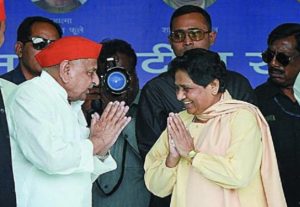
Just like his first term, Mulayam’s second stint too ended abruptly, within two years. By May 1995, the SP-BSP alliance had strained due to conflicting ambitions of the leaders of both parties. On June 2, Mayawati, already Kanshi Ram’s heir apparent to lead the BSP, decided to pull the plug on the Mulayam-led government.
What followed defined the bitter relationship that Mulayam and Mayawati and their two parties have shared ever since – barring their brief rapprochement ahead of the 2019 Lok Sabha polls. SP supporters stormed into a guesthouse in Lucknow where Mayawati was meeting her party members. She was allegedly abused and manhandled by the SP workers before a BJP leader, Brahm Dutt Dwivedi, came to her rescue.
Thus ended Mulayam’s second term as CM and Mayawati, with the BJP’s support, made her debut as CM, though she too managed to stay in office for just four months as President’s Rule was imposed in the state in October 1995.
Brush with PM post
In 1996, Mulayam won his first Lok Sabha election from Mainpuri. A terribly fractured mandate at the Centre and wily political moves by various political leaders had led to the collapse of the first Atal Bihari Vajpayee-led BJP government within 13 days of assuming power. As a host of regional outfits, splinter groups of the former JD and the Left parties came together to form the United Front government, Mulayam’s name was floated for premiership after Jyoti Basu was forced to refuse a similar offer.
Resistance to Mulayam came from unlikely quarters. Lalu Prasad, whose youngest daughter is now married to Mulayam’s grandnephew, refused to support a government led by Netaji. HD Deve Gowda became India’s first ‘accidental prime minister’ – eight years before this title fell on Manmohan Singh.
It was not until 2003 that Mulayam returned as CM of UP for a third time. However, this stint was not on the back of a popular mandate but the result of the Machiavellian machinations that the SP founder had come to be identified with by now.
After the May 2002 UP Assembly polls, Mayawati had become the CM with the BJP’s support but by August 2003 problems in the alliance had forced her to resign. It is widely believed that the BJP tacitly supported Mulayam’s bid to succeed Mayawati. However, as Netaji — conscious of the SP’s vote base among Muslims — did not want to be seen in alliance with the saffron party, his elevation to office was aided by a sudden rebellion by BSP MLAs who extended their support to an SP-led coalition.
Crown for son Akhilesh
The only time Mulayam did succeed in leading the SP to an absolute majority in the UP polls was in 2012 but ironically, instead of taking the CM’s chair for himself, he decided to establish his son, Akhilesh Yadav, as heir to his political legacy.
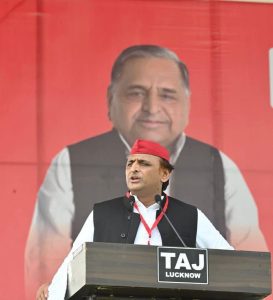
Mulayam’s decision triggered a backlash within his family. In the preceding years, he had brought a number of his family members – brothers, cousins, nephews, et al – into politics. The responsibility of consolidating the SP cadre had been left to his brother Shivpal Yadav, who saw himself as the rightful political heir to his elder brother.
This led to friction within the clan and, by the 2017 UP Assembly polls, the family feud had spilled out in public. Mulayam knew Shivpal had a better hold on the party cadre than Akhilesh and, for a while, sided with his brother over his son. Yet, in due course, he came to endorse Akhilesh, even if grudgingly. However, he reportedly did not support many of Akhilesh’s political moves, like the alliance with the BSP, his attempt to give the SP an image makeover from a party that patronised hoodlums and musclemen to one that is modern in its outlook, or his attempt at broadening the SP’s social base to include non-Yadav OBCs and Dalits.
Off the centre-stage
As Akhilesh strengthened his grip on the party, Mulayam gradually faded into the shadows, helplessly watching the feuds in his family worsening while remaining, in name, the party’s patriarch. Shivpal quit the SP to launch his own splinter group, and Mulayam’s daughter-in-law Aparna (wife of Mulayam’s step-son Prateek) switched to the BJP ahead of the 2022 UP assembly polls.
Evidently, towards the end of a long and remarkable political life, Mulayam became a pale shadow of the political heavyweight he had built himself to be by outsmarting and hoodwinking a whole league of powerful satraps in his prime.

